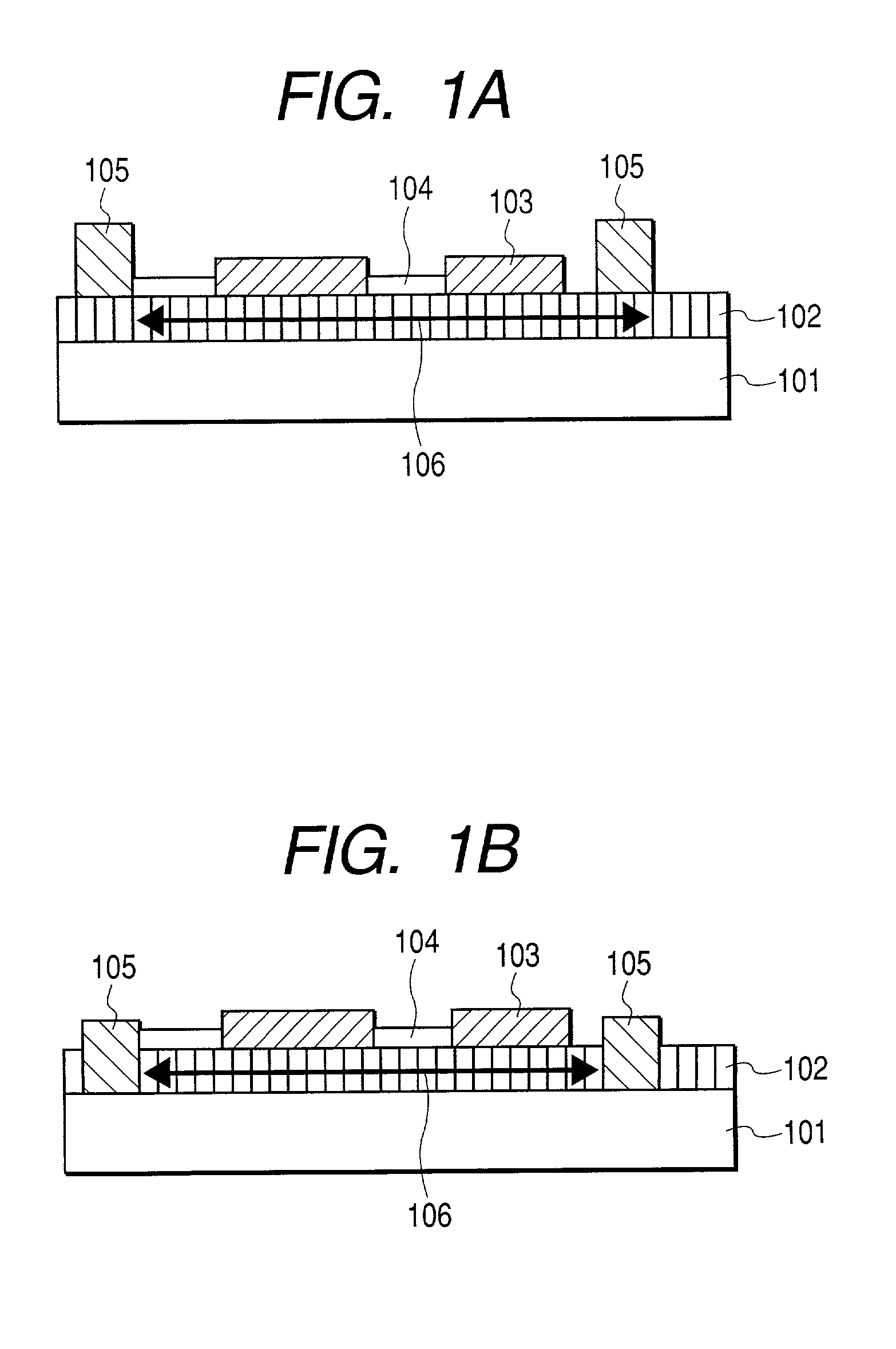Optoelectronic substrate
- Summary
- Abstract
- Description
- Claims
- Application Information
AI Technical Summary
Benefits of technology
Problems solved by technology
Method used
Image
Examples
example 1
[0144] In this Example, anodized alumina was formed on an aluminum plate, and thereon an electric device and an optical device were mounted as illustrated in FIGS. 1A and 1B.
[0145] Firstly, on an aluminum plate, anodized alumina 102 was formed in a thickness of 5 .mu.m. The remaining unanodized portion serves as base plate 101.
[0146] Prior to the anodization, hole-starting points (concaves) were formed on the surface of the aluminum plate by FIB irradiation. This enables the holes regularly arranged in a honeycomb state (triangular lattice state). In this example, a focused ion beam of Ga was projected to form hole-starting points in dots arranged in 360 nm intervals in triangular lattice arrangement, with ion species of Ga, at acceleration voltage of 30 kV, ion beam diameter of 100 nm, ion current of 300 pA, and irradiation time for each dot of 10 msec.
[0147] The anodization was conducted with an apparatus illustrated in FIG. 11, in a 0.3M phosphoric acid bath as the anodization el...
example 2
[0153] In this Example, anodized alumina itself was used as the base plate as illustrated in FIG. 4B, and a device was provided on each of the upper and lower faces respectively, and some of the holes were utilized as via holes to connect electrically and optically the devices on the both faces.
[0154] Anodized alumina was fabricated in the same manner as in Example 1.
[0155] Anodization was conducted in a 0.3 M phosphoric acid solution bath as the electrolyte solution at an anodization voltage of 88 V. Further, a hole-widening treatment was conducted by immersion in a 5 wt % phosphoric acid solution for 40 minutes to obtain anodized alumina of hole intervals of 220 nm and hole diameter of about 100 nm. The remaining aluminum was dissolved by an aqueous mercury chloride to isolate the anodized alumina.
[0156] Subsequently, PMMA (poly-methyl-methacrylate) was filled into the holes to form a waveguide pattern. In this Example, the PMMA-filled holes serve as the waveguide as shown in FIG....
example 3
[0160] In this Example, Fe was filled into fine holes of anodized alumina 102 to have a function of electromagnetic wave absorber 501 as shown in FIG. 5B. In this drawing, the magnetic material was filled into a part of thickness of the holes. Naturally, the magnetic material may be filled into the entire of the holes in the thickness direction, or may be filled only into the holes to be employed as the electromagnetic wave absorber.
[0161] Firstly, an Nb film, and an aluminum film were formed on an Si base plate. The aluminum film was converted to anodized alumina.
[0162] The anodized alumina was adjusted to have a thickness of 5 .mu.m, hole spacings of 300 nm, and hole diameters of 100 nm. Into the holes of the anodized alumina, Fe was filled to a depth of about 1 .mu.m by electrodeposition.
[0163] On the anodized alumina, an electric wiring was formed with electroconductive paste, and electronic devices and optical devices were mounted to obtain an optoelectronic wiring substrate. A...
PUM
 Login to View More
Login to View More Abstract
Description
Claims
Application Information
 Login to View More
Login to View More - R&D
- Intellectual Property
- Life Sciences
- Materials
- Tech Scout
- Unparalleled Data Quality
- Higher Quality Content
- 60% Fewer Hallucinations
Browse by: Latest US Patents, China's latest patents, Technical Efficacy Thesaurus, Application Domain, Technology Topic, Popular Technical Reports.
© 2025 PatSnap. All rights reserved.Legal|Privacy policy|Modern Slavery Act Transparency Statement|Sitemap|About US| Contact US: help@patsnap.com



